Introduction to Indian Textile Art History
The rich tapestry of Indian textile art history is a testament to the country’s profound cultural heritage, spanning centuries of innovation, craftsmanship, and artistic expression. From the ancient civilizations of the Indus Valley to the modern-day bustling streets of its vibrant cities, India’s textile tradition has evolved into a complex mosaic of techniques, styles, and regional influences.
In this exploration of Indian textile art history, we embark on a journey through time, tracing the origins of India’s textile legacy and delving into the cultural, religious, and socio-economic influences that have shaped its development. From the earliest evidence of cotton fragments found in archaeological excavations to the intricate silk sarees meticulously handwoven in traditional looms, each thread in India’s textile narrative weaves a story of resilience, creativity, and ingenuity.
Throughout history, Indian textiles have not only adorned its people but also served as a medium for storytelling, religious rituals, and cultural identity. The intricate patterns, vibrant colors, and luxurious textures of Indian textiles reflect the diverse tapestry of its people and the myriad influences that have left an indelible mark on its artistic landscape.
![Silk Production, Traditional Craftsmanship, Nature And Culture [Credit https://flickr.com]](https://hinduinfopedia.in/wp-content/uploads/2024/02/5780836238_ed3f09c577_o_silk_worm_Flickr.webp)
As we navigate through the various epochs of Indian textile art history, we will encounter the impact of colonialism, the resurgence of traditional techniques in the post-independence era, and the recent embrace of sustainable practices in textile production. We will also shine a spotlight on the master craftsmen and women whose dedication to their craft has earned them national recognition and preserved India’s textile heritage for future generations.
Join us on this odyssey through the warp and weft of Indian textile art history, where every thread tells a story and every fabric bears the imprint of a rich and vibrant culture.
India’s Distinguished Scientific Heritage
India has an illustrious history of scientific achievements and advancements since ancient times spanning intricate fields like astronomy, mathematics, metallurgy, medicine, aviation, agriculture, and more. The country’s ancient Hindu scholars made pioneering discoveries in science and technology long before such concepts emerged elsewhere globally.
In the field of astronomy, India developed an extremely complex calendar system precisely tracking the movement of constellations and celestial bodies. The groundbreaking concept of zero as a number was also formulated in India. India’s prowess in metallurgy can be seen in the Iron Pillar of Delhi constructed during the Gupta era using highly advanced techniques. Sushruta, considered the father of surgery, conducted complex procedures and pioneered surgical tools in the 6th century BCE. The ancient Tamil Sangam literature contains references to flying vehicles, pointing to aviation knowledge. In agriculture, ancient Indian texts tell of well-developed irrigation systems and plowing techniques.
Rich Heritagr of Indian Textile Art
India’s rich textile heritage is deeply intertwined with its scientific legacy, showcasing a blend of innovation and tradition. Millennia ago, ancient Indians utilized Bermuda grass to weave carpets, mats, and beds, exemplifying early textile craftsmanship. This practice underlines the ingenuity in using natural resources for daily necessities, setting the foundation for India’s textile evolution. The “Scientific Foundations Enable Sophisticated Textile Crafts” section highlights how advancements in chemistry, spinning, weaving, and block printing technology have transformed materials like silk, cotton, and cashmere into exquisite textiles, further enriching India’s global textile narrative with its seamless fusion of science and art.
Scientific Foundations Enable Sophisticated Textile Crafts
India’s legacy in science has deeply influenced its textile art, allowing for unparalleled achievements in fabric making. The mastery over chemical processes enabled the creation of vibrant, lasting dyes, a hallmark of Indian textiles. Innovations in spinning and weaving, propelled by an understanding of mechanical principles, facilitated the production of finer threads and more intricate weavings. This scientific acumen, combined with artistic vision, transformed raw materials like silk, cotton, and cashmere into textiles of extraordinary beauty and durability. The development of block printing technology, based on chemistry and engineering, revolutionized fabric decoration, making Indian textiles highly sought after for their intricate designs and vivid colors. Thus, the scientific foundation not only enriched the material quality but also the aesthetic and functional aspects of Indian textiles, showcasing a seamless fusion of science and art.
Unparalleled Textiles Globally Renowned
India’s illustrious textile tradition has long been celebrated on the international stage, a testament to its historical significance and enduring appeal. The establishment of the British East India Company marked a period where India emerged as a pivotal economic powerhouse, contributing significantly to the global economy. Among its diverse exports, which included exotic spices, precious stones, and jewelry, Indian textiles stood out for their exceptional quality. The subcontinent’s expertise in crafting exquisite silks, fine cotton, and gossamer muslins enchanted markets from Europe to Asia, establishing a legacy of excellence that persists to this day. Indian textiles are now revered globally, emblematic of both artistic mastery and unparalleled quality.
Global Recognition of Indian Textiles
The acclaim for Indian textiles on the global front is a reflection of the country’s sustained excellence in craftsmanship and artistic innovation. Generations of weavers, dyers, and artisans have been at the forefront of preserving traditional techniques while also incorporating modern innovations, producing textiles that are both beautiful and complex. This commitment to excellence has positioned India as the third-largest textile exporter worldwide, trailing only behind China and Germany. With exports totaling approximately $37.11 billion, India’s textile industry is a vibrant part of its economy, showcasing the country’s rich cultural heritage and its significant role in the global textile market.
Geographic and Technological Diversity Shapes
Nestled within India’s varied topography lies a panorama of textiles, each region narrating its own saga through the warp and weft of its fabrics. These textiles are not just threads and colors; they are a dialogue between India’s rich heritage and its innovative future, reflecting the symbiosis of environment and ingenuity.
Regional Textile Specialities
India, a vast country replete with economic, political, cultural, and linguistic diversities, presents a rich mosaic of regional textile traditions. Each region’s unique environmental, cultural, and historical contexts have shaped distinctive textile styles that are a testament to the country’s multifaceted diversity. To explore the intricate relationship between these regional diversities and their textile expressions, we delve into an in-depth study of how geographic diversity influences textile craftsmanship and aesthetics across India.
Bridging Tradition and Modernity
Indian textiles, with their profound regional diversity, have long been a wellspring of inspiration for contemporary fashion and global textile trends. Each region, with its distinct textile heritage, has contributed uniquely to the tapestry of global fashion, demonstrating how traditional crafts can shape modern aesthetics and innovation. This interplay between regional specificity and global appeal underscores the significant impact of India’s geographic diversity on textile styles, both within and beyond its borders.
North to Global Runways
The luxurious Pashmina shawls of Kashmir and the vibrant Phulkari embroidery of Punjab have transcended their local origins to become staples in international fashion. Designers worldwide draw upon the intricate patterns and exceptional craftsmanship of these textiles, integrating them into high fashion collections that grace global runways. The adaptability of Pashmina, for instance, has seen it evolve from traditional shawls to modern apparel and accessories, blending seamlessly with contemporary fashion sensibilities while maintaining its artisanal heritage.
From Panipat to International Homes
Panipat’s robust textile industry, renowned for its blankets, carpets, and upholstery fabric, exemplifies how regional craftsmanship can cater to global markets. The city’s ability to innovate while preserving traditional techniques has made its products a favored choice in international home décor, showcasing how regional industries can achieve global relevance through quality and innovation.
Eastern Weaves on Western Shores
The intricate Jamdani muslins and vibrant silks of Bengal have made a significant mark on the global textile scene, influencing both fashion and fabric technology. The delicate art of Jamdani weaving, with its sheer textures and elaborate motifs, has been embraced by fashion designers seeking to infuse their collections with a blend of tradition and transparency, a testament to the universal appeal of Bengal’s textile heritage.
Southern Silks in Global Wardrobes
Kanjeevaram silk saris from Tamil Nadu and the fine silks of Andhra Pradesh have not only adorned the wardrobes of the Indian diaspora but have also captivated international audiences. Their rich textures, vibrant colors, and exquisite craftsmanship have found expression in global luxury fashion, with designers incorporating these traditional fabrics into contemporary designs that appeal to a broad audience.
The influence of India’s regional textile traditions on contemporary fashion and global trends is a vibrant example of how cultural heritage can inform and enrich global aesthetics. This fusion of tradition and modernity not only preserves the rich tapestry of Indian textiles but also contributes to the dynamic evolution of global fashion, demonstrating the enduring impact of geographic diversity on textile styles.
Technological Influence: Balancing Tradition with Innovation
As we celebrate the rich tapestry of Indian textiles, from the vibrant Phulkari of Punjab to the exquisite Kanjeevaram silks of Tamil Nadu, it’s crucial to also consider the role of technology in these age-old crafts. While the essay has touched upon the minimal use of modern machinery, a deeper dive into how technology intersects with tradition can offer insights into the future of these textiles.
Embracing Modernity to Preserve Heritage
The Indian textile industry is at a crossroads, where the preservation of traditional methods meets the potential of modern technology. Innovations in textile production, from automated looms to eco-friendly dyeing techniques, are not merely about efficiency; they’re about ensuring the sustainability and relevance of traditional crafts in a global market. This balance is delicate, as the introduction of technology must respect and retain the essence of the craftsmanship that gives Indian textiles their unique identity.
Technology as a Catalyst for Tradition
In regions like Panipat, known for its textile industry, and Chanderi, famous for its muslins and cotton sarees, technology has been a catalyst for growth. Advanced weaving and dyeing technologies have enabled artisans to increase production without compromising the quality or intricacy of their designs. Moreover, digital platforms have opened up new markets, allowing local artisans to showcase their work to a global audience, thus preserving their heritage while embracing the opportunities presented by the modern world.
Sustainable Practices and Innovation
The integration of technology also brings attention to sustainable practices within the textile industry. Innovations in recycling processes, water conservation, and the use of organic materials are examples of how technology can enhance the environmental sustainability of textile production. By adopting these technologies, the Indian textile industry not only contributes to the preservation of the environment but also meets the growing global demand for sustainable and ethically produced goods.
5. Geographic Diversity in Indian Textiles
India’s vast geography has given birth to distinct textile traditions in each region. The environment, culture, and history of each area play a crucial role in shaping these unique styles.
Specialized Textiles of the North
Northern India’s textile panorama spans from Kashmir’s soft Pashmina shawls to Punjab’s colorful Phulkari embroidery. These textiles, enriched by generations of craftsmanship, reflect each region’s cultural identity and artisanal excellence.
Textile City of Panipat:
Panipat, the “City of Weavers,” stands out for its diverse textile production. Its industry, pivotal in India’s textile exports, is marked by a tradition of innovation and quality.
Phulkari Embroidery, Punjab:

Phulkari represents Punjab’s cultural essence through vibrant colors and intricate patterns, making it a significant element of Indian textile art history.
Exclusive Production from Hilly Wools
Ladakh’s severe winters have given rise to Pashmina shawls, known for their warmth and softness, showcasing the adaptation of crafts to local climates. Jamawar shawls further illustrate the region’s ingenuity in combining Pashmina with other fibers for varied use.
Pashmina Shawls, Kashmir:

These shawls, crafted from Changthangi goat wool, are a testament to Kashmir’s rich heritage of delicate handwork and cultural depth.
Flourishing Muslins and Silks of Bengal
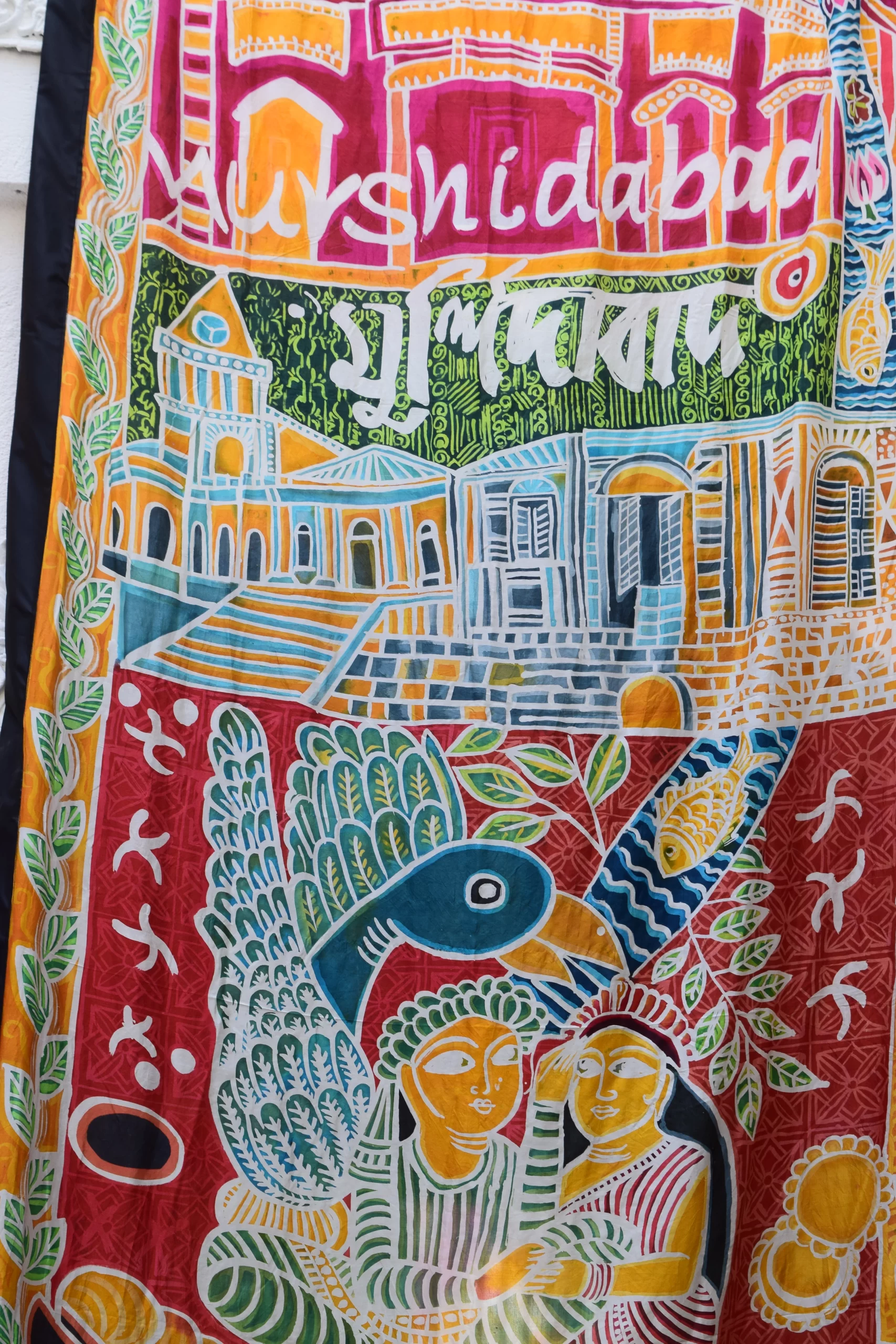
Lustrous Kanchipuram Saris of the Coromandel
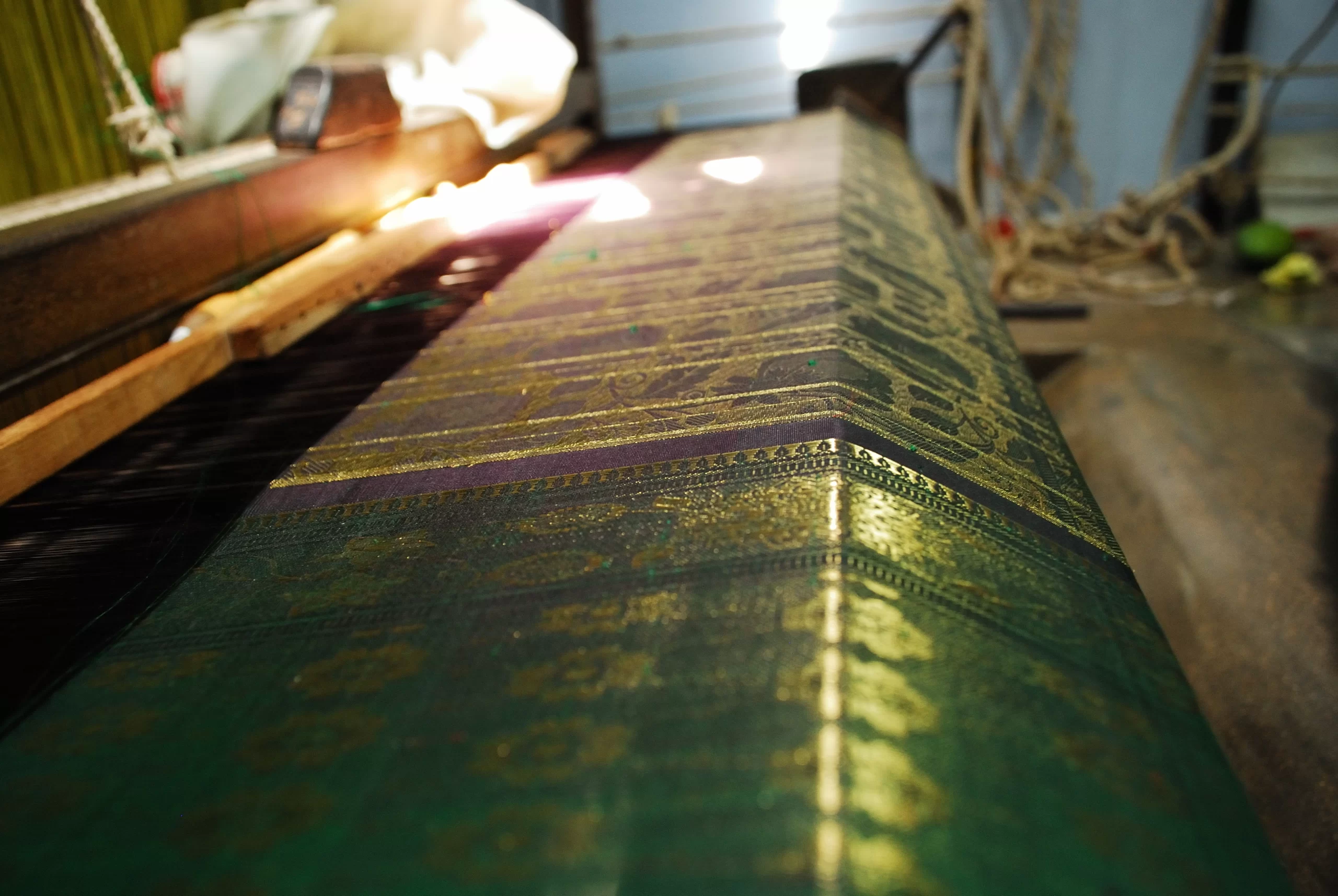
Silk Weaving Traditions of Andhra
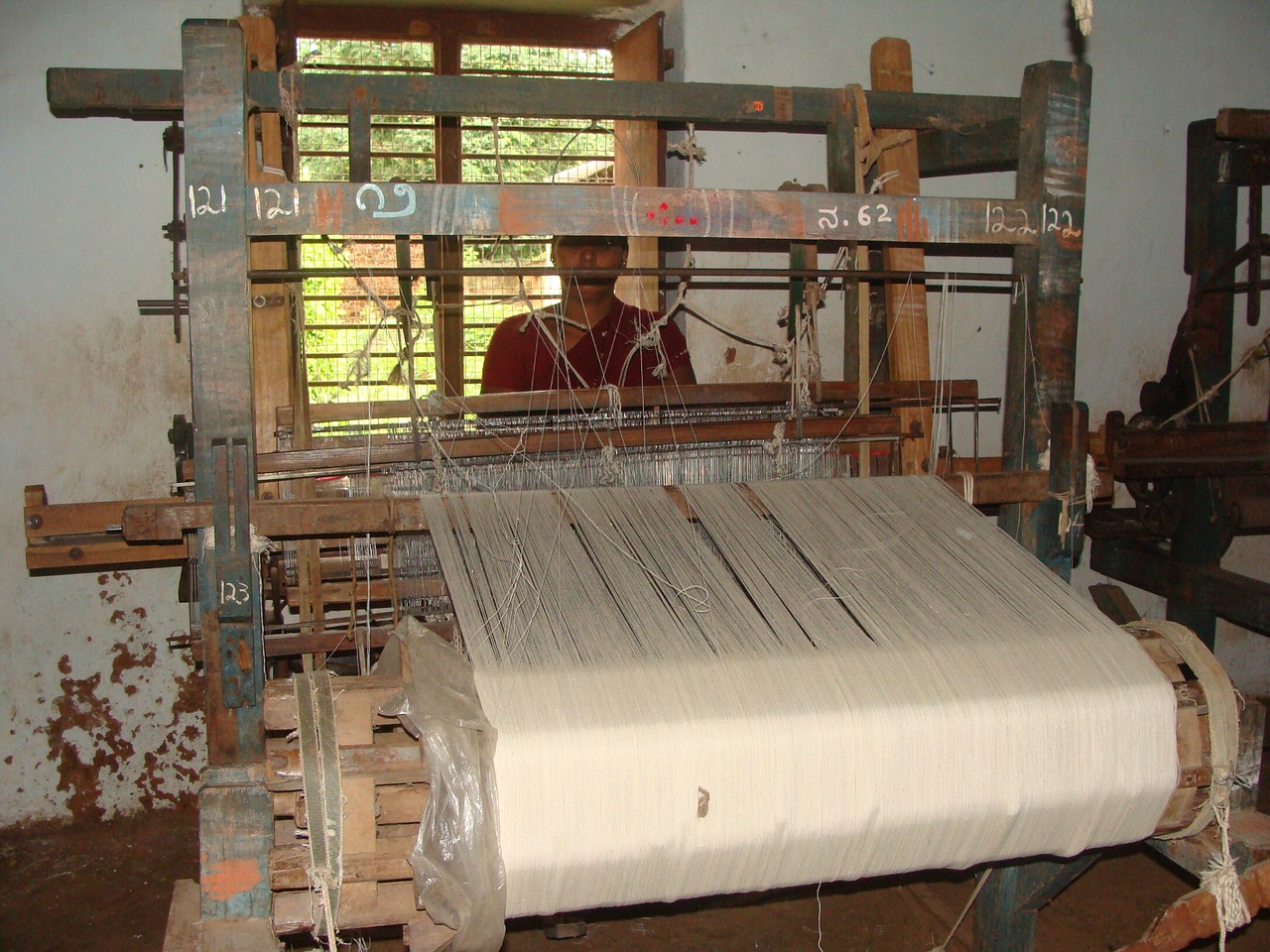
In the heart of Andhra Pradesh, the Dharmavaram and Uppada regions are renowned for their exquisite silk saris, each a masterpiece of traditional weaving techniques and artistry. The Dharmavaram silk saris, characterized by their robust textures and typically rich, earthy colors, are often adorned with elaborate motifs that include temples, elephants, and peacocks, reflecting the cultural and spiritual legacy of the region. The incorporation of gold-threaded zari in these saris adds a dimension of luxury and opulence, making them a favored choice for brides and festive occasions.
Uppada silk saris, on the other hand, are celebrated for their lightweight and soft texture, which contrasts with the intricate and often expansive zari work that embellishes them. These saris frequently display a lustrous sheen and fluidity, making them exceptionally graceful and suitable for the hot climatic conditions of Southern India. The color palette of Uppada saris is typically vibrant, featuring a blend of bold and pastel hues that complement the intricate zari designs, often inspired by nature and local folklore.
The weavers of these regions employ a time-honored technique known as ‘jamdani,’ a labor-intensive handloom process that requires meticulous attention to detail and exceptional skill. This method involves weaving each sari slowly and carefully to ensure the precision of the elaborate designs and the uniformity of the zari work, which is often so fine that the saris are sometimes referred to as ‘woven poetry.’
The prominence of Dharmavaram and Uppada silk saris within Indian textile art history is not merely due to their beauty but also their embodiment of the region’s dedication to preserving the legacy of handloom silk weaving. These saris represent more than just attire; they are cultural artifacts that carry forward the traditions, stories, and artistry of Andhra Pradesh, securing a prominent place in the annals of Indian textile heritage.
Diaphanous Cottons of Central India
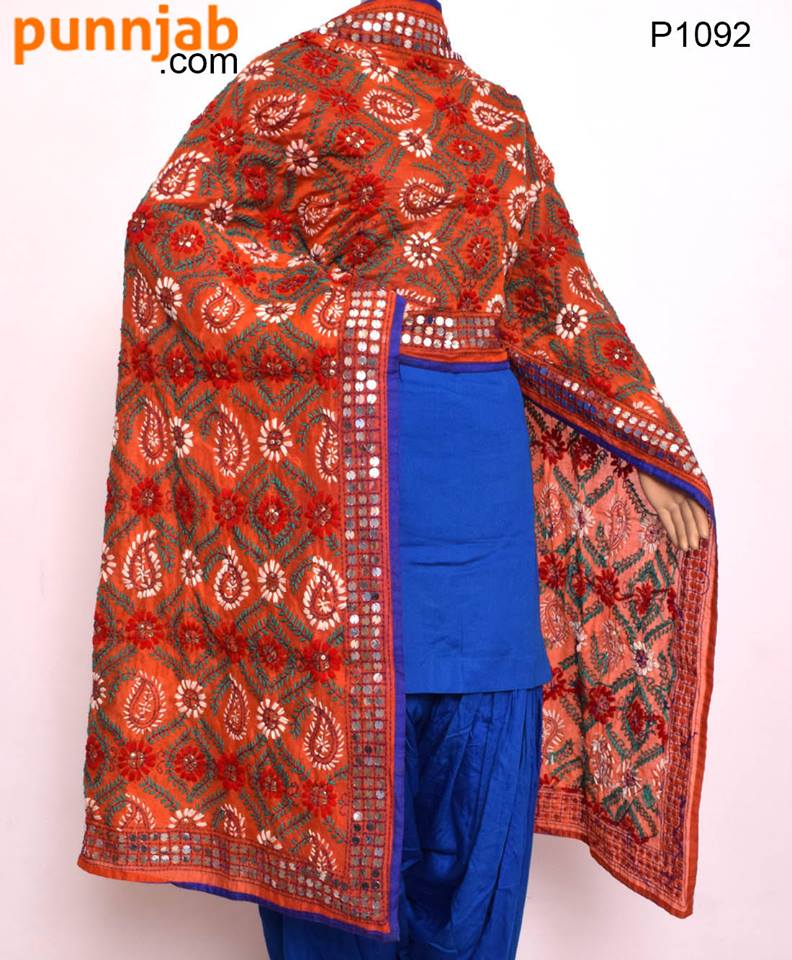
Chanderi’s weaving, utilizing the high-quality cotton of the Malwa region, is known for producing exquisite muslins and cotton saris. This practice enriches the narrative of Indian textile art history, showcasing Chanderi’s distinctive contribution.
Bandhani from Gujarat
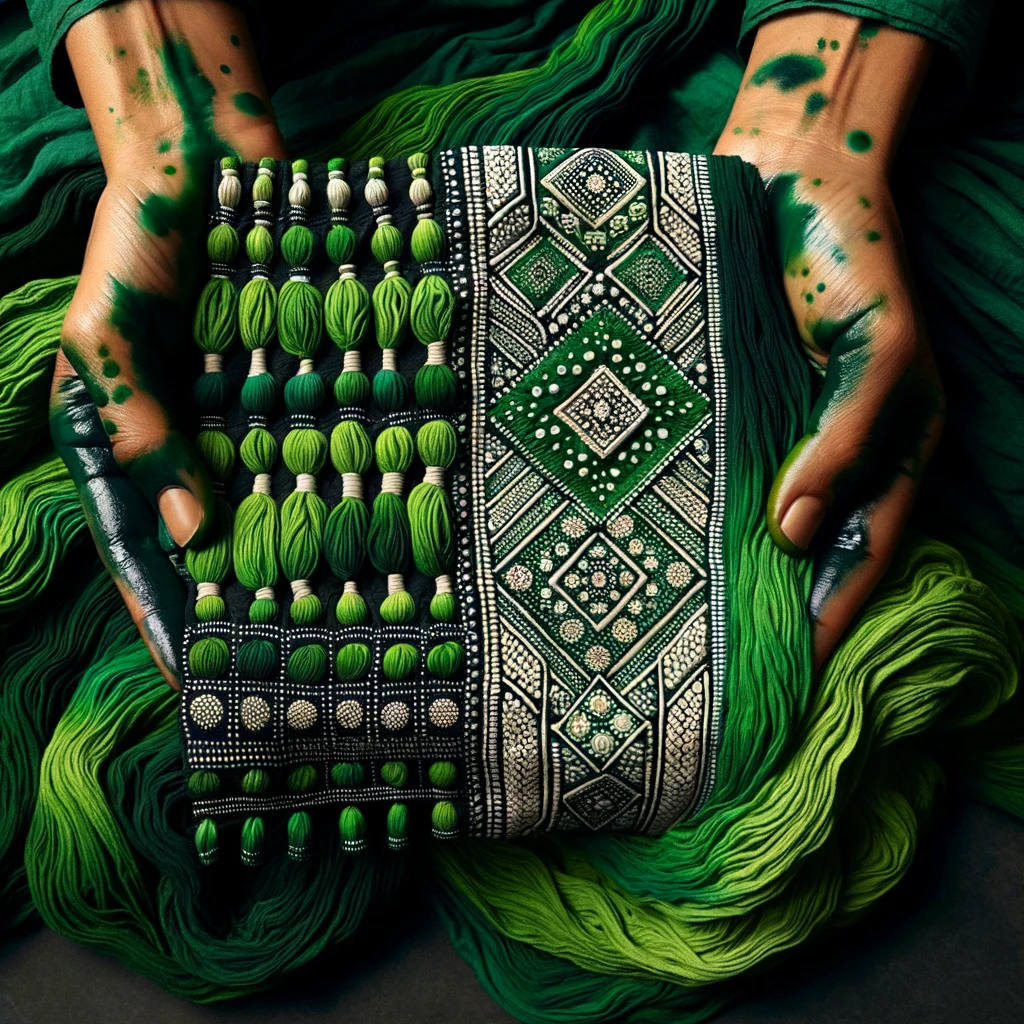
The Bandhani craft, a treasured art form hailing from Gujarat, is a brilliant representation of India’s age-old tie-dye technique. Known locally as ‘Bandhej,’ it is a method where the fabric is plucked with fingernails and then tightly bound with threads before being dyed, creating mesmerizing patterns and motifs that burst with color upon the fabric. This meticulous process results in an array of dots, stripes, and figurative designs, each a testament to the artisan’s precision and creativity.
Historically, the colors and patterns in Bandhani were often used to signify different stages of life, with certain hues and motifs reserved for occasions such as weddings or festivals. This cultural coding within the Bandhani patterns is a language of its own, representing the vivid social tapestry of Gujarat.
In modern fashion, Bandhani has transcended its traditional boundaries to become a symbol of fusion wear. Designers incorporate the distinct patterns of Bandhani into everything from haute couture to everyday apparel, showcasing the versatility of this craft. The adaptability of Bandhani has been embraced not only in India but globally, as the technique offers a unique texture that can complement various fashion statements.
Furthermore, the Bandhani craft is embracing the principles of sustainability that are increasingly important in the textile industry. Artisans are shifting towards natural dyes derived from plants, fruits, and flowers, reducing the environmental impact of their work. Water recycling methods and sustainable practices in fabric production are also being adopted, contributing to the eco-friendly fashion movement.
The dynamic evolution of Bandhani is a prime example of the enduring relevance of traditional crafts within Indian textile art history. It reflects an ongoing dialogue between maintaining heritage techniques and adapting to contemporary trends and ethical practices. As such, Bandhani is not only a craft but a living narrative, continuously weaving its story into the fabric of Indian culture.
Cultural Influences in Indian Textile Art
Indian Textile Art History is rich with cultural, religious, and social influences. Every region has its own story woven into its fabrics. The designs, motifs, and techniques used in textiles often reflect local legends, beliefs, and customs. For instance, the use of specific colors and patterns can denote marital status, religious affiliation, or social rank. This depth adds a unique character to Indian textiles, making them more than just items of clothing or decoration.
Sacred Threads in Indian Textiles
Indian textiles are steeped in religious significance, with ceremonial fabrics often adorned with symbols that bridge the tangible and spiritual realms. The craftsmanship of these textiles is a devotional act, with weavers infusing each creation with spiritual motifs, thereby embedding a sacred essence within the threads.
Rakhi: The Bond of Protection
The vibrant Rakhi thread, tied during the Raksha Bandhan festival, epitomizes the cultural profundity of Indian textiles. More than an adornment, the Rakhi is a symbol of protection and affection between siblings, a tangible representation of cultural values woven into the fabric of society.
Kaleva: The Red Thread of Blessings
Similarly, the Kaleva threads embody goodwill and spiritual well-being. Used in various ceremonies, these red threads tie individuals to the cultural and spiritual ethos of Indian heritage, representing a continuum of traditional beliefs carried forward through time.
The Bhagavad Gita Interpreted Through the Looms of Hemoprova Chutia
Modern Threads: The Contemporary Relevance of Traditional Textiles
Indian culture, rich in its tapestry of diversity, has emerged as one of the most composite cultures globally, drawing strength from its ancient traditions, the compassionate ethos of its majority community, and a heritage rooted in tolerance. The complex interweaving of different customs, values, and beliefs through centuries has created a cultural fabric as intricate and vibrant as the textiles it has birthed. In this milieu, Indian textiles have always been more than mere threads and colors; they are narratives of civilization, markers of identity, and bridges between the past and the present.
Blending the Old with the New
In the Post-Independence Renaissance, India witnessed a cultural rebirth that infused traditional textiles with contemporary relevance. Visionary designers and skilled artisans began to interlace time-honored weaving and dyeing techniques with modern design sensibilities, ensuring that these traditional textiles maintained their allure in the ever-evolving fashion landscape. This creative synergy not only preserved the legacy of Indian Textile Art History but also redefined it, allowing it to dynamically evolve and resonate with the rhythm of modern times.
Sustainable Fashion and Cultural Identity
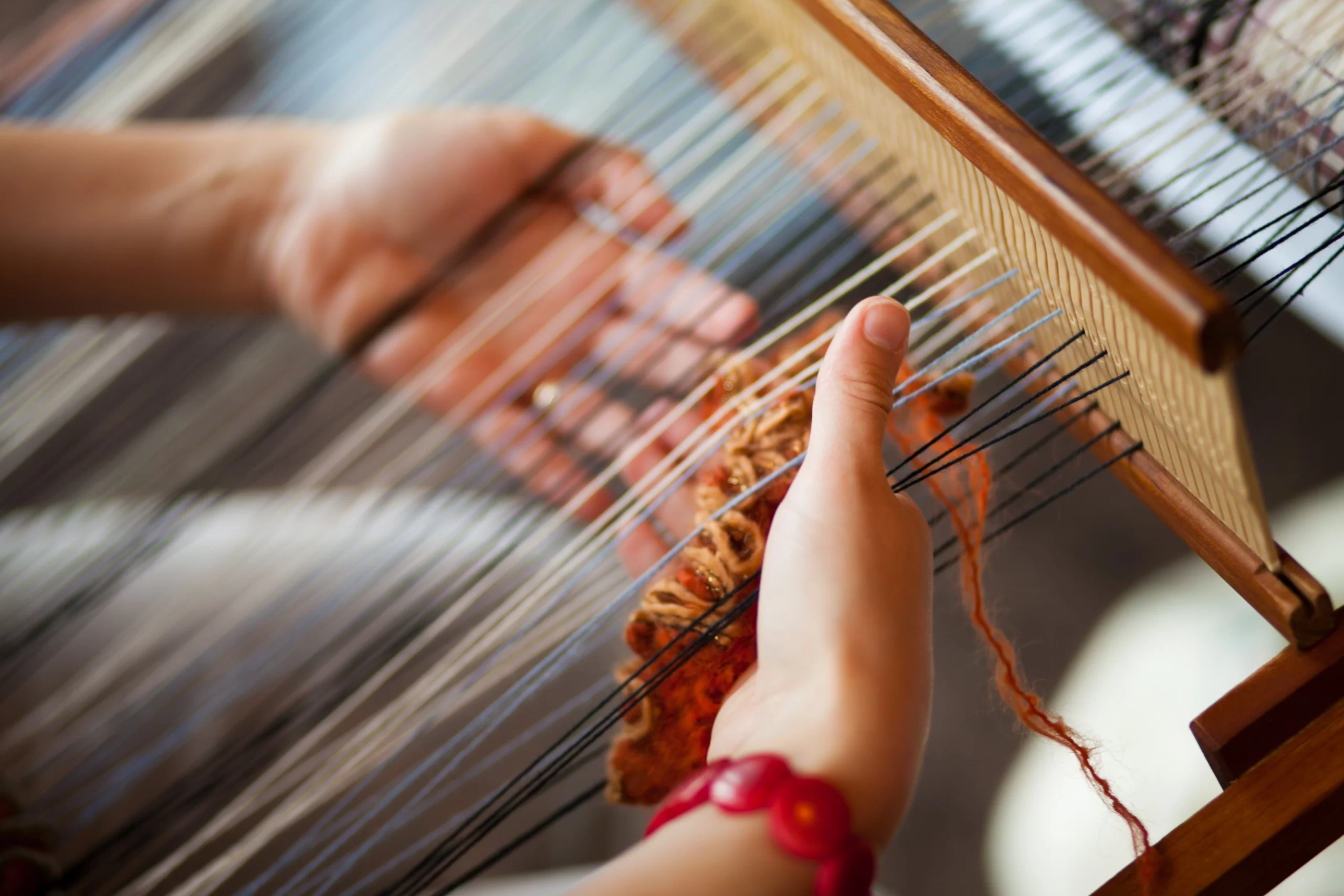
Today, traditional Indian textiles stand at the intersection of sustainability and cultural preservation. They offer an eco-friendly alternative to fast fashion. Wearing traditional fabrics is a statement of environmental consciousness and cultural pride. This trend highlights the ongoing importance of India’s textile heritage in shaping a sustainable and culturally rich future.
Brief History of Indian Fabric Art and Industy
Tracing the weft and warp of India’s history, one finds the rich threads of textile artistry interlaced with the cultural fabric of the nation. Each weave tells a story, each pattern encapsulates an era, setting the stage for an odyssey through the annals of Indian Fabric Art and Industry.
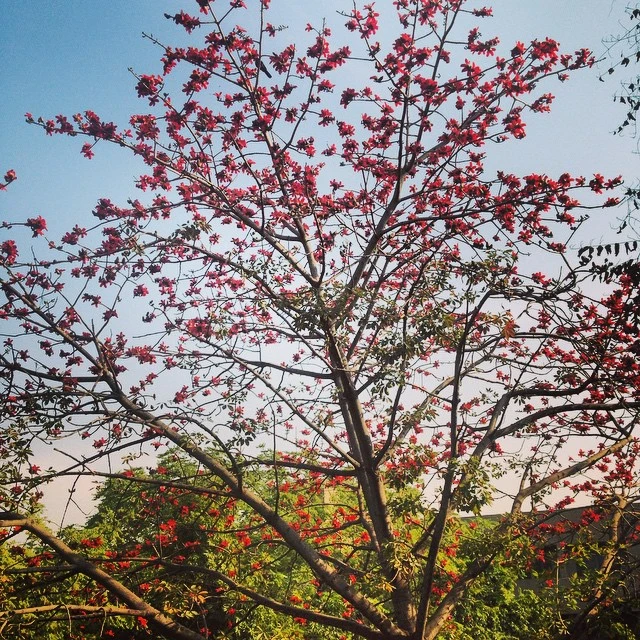
Ancient Beginnings to Global Hub:
The seeds of India’s textile prowess were sown during the Indus Valley Civilization, evidenced by archaeological finds of cotton and wool. This period set the foundation for India’s textile heritage, which flourished with the sericulture of silk and the cultivation of cotton, establishing the subcontinent as an early textile nexus.
Medieval Innovations to Colonial Disruptions:
Advancing into the medieval era, the confluence of Persian and Islamic artistry enriched the Indian textile repertoire with intricate designs and a spectrum of dyes. However, the advent of European commerce and British colonialism later upended this thriving ecosystem, as local production was undercut by imported British textiles, challenging the livelihoods of Indian artisans.
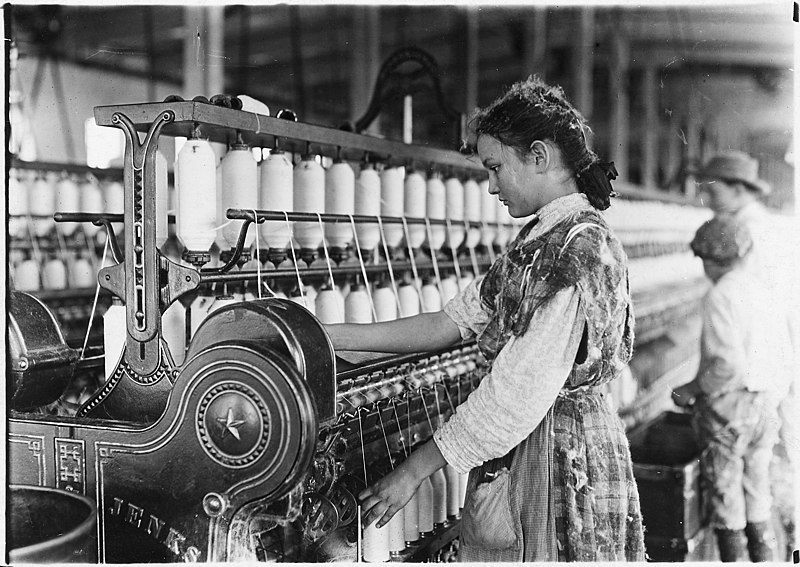
Post-Independence Renaissance:
Emerging from colonial shadows, post-independence India witnessed a resurgence of its traditional textile arts, now interwoven with modern technology. This era was pivotal in reinvigorating indigenous methods and celebrating the nation’s textile heritage.
Contemporary Innovations and Sustainability:
Today, the Indian textile industry commands a global presence, balancing time-honored artisanship with contemporary trends and sustainable practices. This balance is critical for the industry’s contribution to both the global fashion scene and India’s economy.
Conclusion:
India’s textile journey, from its ancient roots to its modern achievements, is a narrative of adaptability and resilience. Indian textiles have continuously evolved, harmonizing past techniques with present-day innovations. As the industry forges ahead with a commitment to sustainability, it honors India’s rich legacy while adapting to a rapidly changing world, showcasing the nation’s perpetual ability to innovate and thrive.
Advancing Sustainability Reporting in Indian Fabric Industry
The Indian fabric industry, pivotal to the nation’s economic vitality through significant contributions to employment, exports, and GDP, has reached a crucial juncture that balances economic growth with ecological and social stewardship. The practice of sustainability reporting has emerged as a vital mechanism for fabric manufacturers, offering transparency on their environmental, social, and governance (ESG) performance. This detailed exploration delves into the nuanced landscape of sustainability reporting in the Indian fabric sector, dissecting its challenges, celebrating its strides, and contemplating the path ahead.
Current Practices and Ethical Heritage:
India’s tradition of extracting colors from plants for fabric dyeing is a testament to an ancient, sustainable ethos. This practice continues with the use of plants like Aloe vera, yielding greenish-yellow hues, and Neem, producing a light green shade. Annatto offers a natural orange, while Turmeric imparts its signature vibrant yellow. Pomegranate rinds and Oak Galls provide yellowish-orange and brown dyes, respectively, and even Thyme contributes a pale green to the natural dye palette. These practices embody a commitment to environmental consciousness and represent a continuity of India’s age-old sustainable methods in textile coloring, which are increasingly valuable in the face of global synthetic dye pollution.
Despite these roots in sustainability, the industry confronts considerable challenges in fully integrating and reporting these practices. The lack of uniform reporting frameworks and the constraints faced by SMEs highlight the discrepancy between traditional sustainable practices and modern reporting and operational standards.
Achievements in Reporting Standards:
There has been commendable progress with some fabric manufacturers embracing international reporting standards such as the GRI and SASB, thus fortifying the trustworthiness of their sustainability disclosures. The fabric industry has also seen collaborative ventures among industry bodies, governmental agencies, and NGOs, all aiming to amplify the impact of sustainability reporting and to foster educational initiatives for capacity building.
Navigating Future Pathways:
Looking forward, the advancement of sustainability reporting in the Indian fabric industry hinges on the development of standardized frameworks that are accessible to all scales of enterprise. Building the capacity of SMEs to navigate and implement these frameworks is equally crucial. Policy interventions, including mandatory sustainability disclosures and incentives for green investments, could catalyze a shift towards more sustainable practices industry-wide.
Conclusion:
Sustainability reporting stands as a cornerstone for the Indian fabric industry’s journey towards a responsible and ethical future. By addressing the existing challenges and harnessing opportunities for collaborative growth and policy-supported initiatives, the industry can pave the way for a greener, more sustainable future. This journey, while rooted in the rich heritage of Indian textiles, charts a course towards a globally competitive and ecologically harmonious future, reflecting the depth and adaptability of Indian fabric art and industry.
The Impact of Colonialism on Indian Textile Art
The colonial era brought significant challenges to India’s textile sector. British policies favored imports of cheap, machine-made fabrics. This devastated local artisans and their traditional crafts. The once thriving industry faced decline. Artisans lost their livelihoods, and unique textile techniques neared extinction. The Swadeshi movement emerged as a response. It encouraged the revival of Indian textile art and the boycott of British goods. This period marked a crucial chapter in Indian Textile Art History. It highlighted the resilience of Indian crafts in the face of adversity.
Swadeshi Movement: Reviving Traditional Textiles

The Swadeshi movement played a pivotal role in Indian Textile Art History. It was not just a political protest but a cultural resurgence. Artisans reconnected with ancient techniques. Communities supported local textiles like khadi. This movement helped preserve India’s rich textile heritage. It also laid the foundation for modern efforts to protect and promote traditional crafts.
Technological Innovations Post-Independence
Post Independence also the textile industry has suffered owing to the policies of the government. Not many revolutionary changes were made by successive government to improve the sector improvement. However, during the period of PM Narendra Modi a series of steps are taken. They are summarily described here:
Bridging Traditions and Modernity
After independence, India’s textile industry embraced technological advancements. Innovations in weaving and printing enhanced the quality and diversity of fabrics. Digital technologies allowed for intricate designs on traditional textiles. This blend of old and new enriched Indian Textile Art History. It ensured traditional crafts thrived alongside modern techniques.
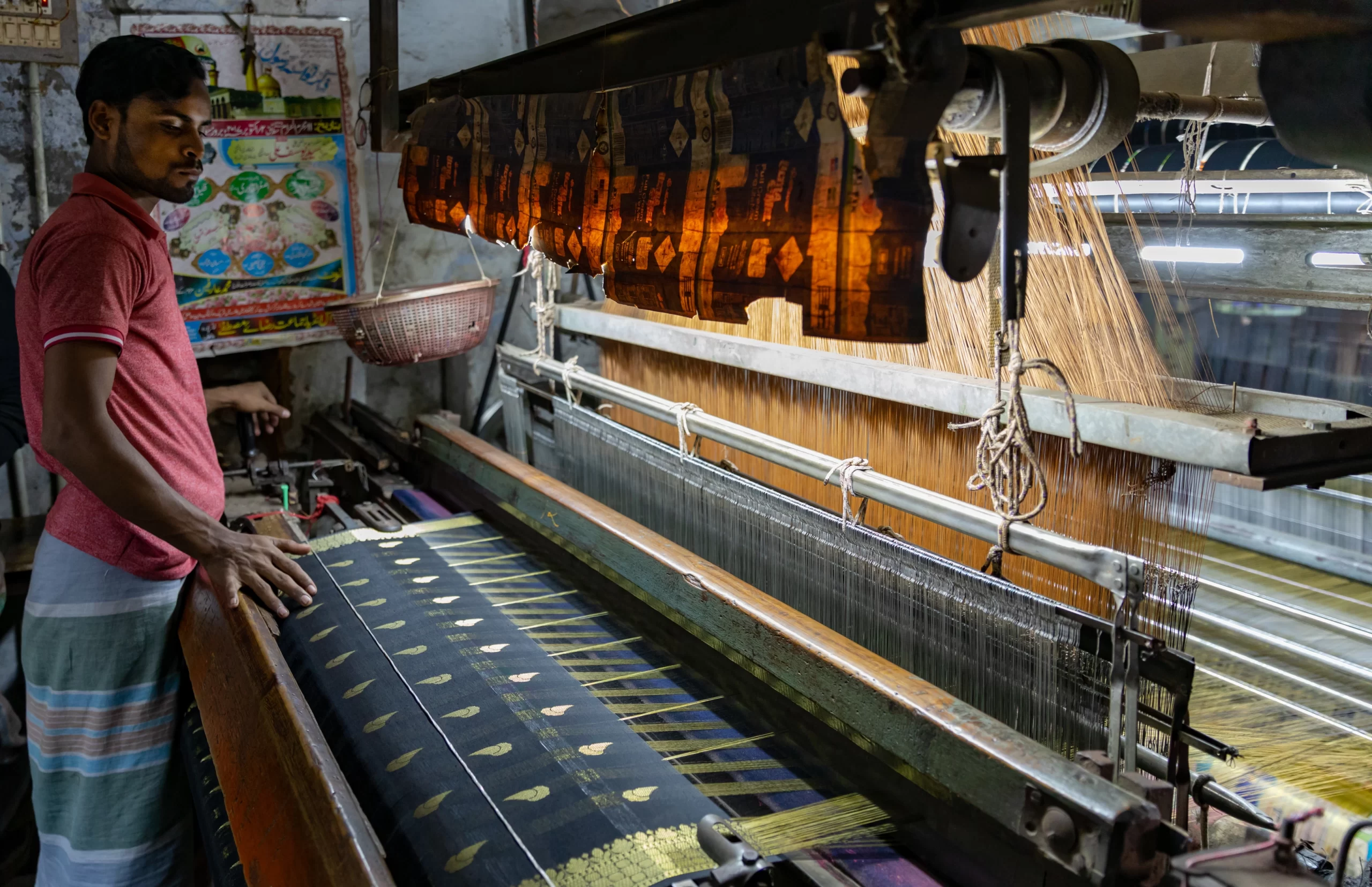
Freedom Versus Labour Rights:
Independence also brought with it the rights of the labours. And Union leaders took full advantage of these rights. Union Leaders propagated large scale labour strikes ending up in closing down the industries and destroying the rights of the labours at the same time. This is particularly true for mills in Mumbai.
Revolutionary Steps taken in last 10 years
- Technology Upgradation Fund Scheme (TUFS): While TUFS was not introduced by Modi’s government, it has been continued and modified to encourage the upgrade of textile industry technology, aiming to make the sector globally competitive by facilitating the adoption of state-of-the-art machinery and equipment.
- Amended Technology Upgradation Fund Scheme (A-TUFS): Launched in 2016, this scheme was designed to specifically target employment generation and export by promoting technical textiles, apparel, and garment sectors. It aimed to attract investment in these high-value segments of the textile industry.
- Production Linked Incentive (PLI) Scheme: Announced in 2020, the PLI scheme for textiles focuses on boosting manufacturing in the country by incentivizing production in man-made fiber (MMF) garments, MMF fabrics, and 10 segments/products of technical textiles. The scheme encourages large-scale production and aims to make Indian manufacturers globally competitive.
- Integrated Wool Development Programme (IWDP): This program was launched to enhance the quality and production of wool and woolen products, supporting the entire value chain of the wool sector.
- Scheme for Integrated Textile Parks (SITP): While also not a new initiative under Modi’s government, SITP has been continued and strengthened to provide the industry with world-class infrastructure facilities for setting up their textile units.
- National Technical Textiles Mission: Announced in the 2020 budget, this mission aims to position India as a global leader in technical textiles. It focuses on research and development, enhancing export potential, and increasing domestic use of technical textiles.
- Rebate of State and Central Taxes and Levies (RoSCTL): Expanded and extended for the textile sector, this scheme aims to make Indian exports competitive by refunding duties and taxes not reimbursed through other mechanisms.
- Labor law reforms: While not specific to the textile sector, labor law reforms proposed under Modi’s government aim to simplify and modernize labor regulations, potentially benefiting the textile sector, which is labor-intensive.
- Promotion of Khadi and Village Industries: There has been a significant push to promote Khadi and village industries through various initiatives, marketing campaigns, and the establishment of Khadi plazas.
- Special Package for Garment Sector: This package includes measures like increased overtime caps, fixed-term employment, and additional incentives for employment generation in the garment manufacturing sector.
Sustainable Practices in Textile Production
The textile sector also turned towards sustainability. Organic dyes and eco-friendly materials became more common. This shift not only preserved the environment but also upheld the ethical values inherent in traditional Indian textiles. Such practices highlight a commitment to a sustainable future for Indian textile art.
Iconic Saree Weaving Traditions Recognized by UNESCO
In the rich tapestry of Indian culture, the threads of tradition and artistry interlace to form a heritage as enduring as it is exquisite. UNESCO’s recognition of Indian saree weaving clusters is a testament to this legacy, honoring the hands that craft beauty from memory and skill.
Heritage of the Loom: UNESCO’s Ode to Indian Weaves
UNESCO’s tribute to India’s saree weaving clusters is a profound acknowledgment of the country’s deep-rooted textile heritage. This prestigious recognition celebrates the weavers’ unparalleled skill and dedication to preserving ancient patterns, colors, and designs, ensuring that these living traditions continue to flourish.
Chanderi and Maheshwar: Woven Elegance of Cotton and Silk
The twin legacies of Chanderi and Maheshwar are emblematic of the fusion between cotton and silk, a testament to the ingenuity of Indian weavers. The urban designs of these regions mirror the weavers’ lives, and the iconic muslin of Chanderi, with its ethereal quality and Persian-inspired motifs, showcases the historical intermingling of cultures.
Kanchipuram: Sacred Geometry in Silken Threads
In Kanchipuram, the grandeur of temple architecture is immortalized in silk, with motifs such as the ‘koyambu’ and geometric patterns adorning the exquisite sarees. The collective knowledge of loom setup, dyeing, and zari work, honed over generations, underscores the community’s commitment to their craft.
Sualkuchi: Legacy of Assamese Silk
Sualkuchi’s mention in revered texts such as the Arthashastra underscores its longstanding silk tradition. The tribal weavers of this region transform the golden threads of muga silk into exquisite fabrics, using age-old techniques on backstrap looms in their open-air courtyard homes.
Kashmir’s Pashmina: Renaissance of a Royal Craft
The narrative of Kashmir’s Pashmina shawls is one of revival from the brink of oblivion. Historically celebrated and then nearly lost, the Pashmina craft saw a revival that restored its former glory. Efforts from dedicated individuals, supported by institutions like the Craft Development Institute and initiatives like GI certification from groups such as the Looms of Ladakh, have been crucial in this renaissance.
Through each chapter, from Chanderi to Kashmir, UNESCO’s recognition not only commemorates the artistic excellence of these traditions but also encourages their safeguarding and continuation in the modern era. These weaving arts, alive with history and skill, are intrinsic strands of India’s cultural identity and continue to inspire and attract admiration worldwide.
Biographies of National Award Winners

In the loom of time, the threads spun by the virtuosos of Indian textiles entwine to form the rich fabric of the nation’s history. This section unfolds the stories of those whose deft hands have been honored by the nation, weaving not just textiles but also the narrative of India’s cultural inheritance.
In the Looms of Legends: The Artisans Who Weave India’s Stories
India’s textile narrative is enriched by the stories of its National Award-winning artisans, whose hands are instruments of tradition, weaving not just fabrics but also the identity of a nation.
Hemoprova Chutia: Weaving the Ethos of the Bhagavad Gita
Image 3: Hemoprova Chutia, in a moment of quiet concentration, channels centuries of tradition into her loom. As she weaves the sacred text of the Bhagavad Gita into fabric, her artistry exemplifies the spiritual and cultural depth of Indian textiles. This imagery serves as a powerful visual anchor for her biography, reflecting her profound impact on the Indian textile narrative.
Masters of the Craft
Each awardee’s story is a tapestry of individual triumph, communal upliftment, and cultural perpetuation. From Gobardhan Panika’s ikat to Rajkumar Tak’s Bandhani, each artisan has innovated within their craft while upholding the ancestral threads of Indian textile art. They have not only preserved the legacy of their respective crafts but also infused them with a modern vibrancy that resonates in today’s global marketplace.
Gobardhan Panika: Ikat Innovation Personified
Panika’s ikat work is a dance of color and precision, a technique that he has both inherited and redefined. His designs, a contemporary retelling of traditional motifs, have placed Odisha’s ikat on the world map, securing his role as a custodian of this intricate art form.
Rajkumar Takur: A Symphony in Bandhani
Tak’s artistry in Bandhani is a celebration of color and pattern, his hands skillfully coaxing the fabric into a constellation of designs. His national recognition is a nod to the enduring allure of this resist-dyeing technique that he has both preserved and transformed.
Ram Kishore Chippa Derawala: The Block Printing Bard
Derawala’s block prints tell stories in pigment and pattern, as he bridges the gap between tradition and contemporary taste. His work with blocks is a dialogue with history, ensuring the block printing craft continues to thrive in the modern era.
Jyotika Jhalani: Pashmina’s Modern Muse
Jhalani’s contributions have reinvigorated the Pashmina weaving tradition with designs that whisper of Ladakh’s past. Her award-winning work is a testament to the finesse and artistry that Pashmina, the ‘soft gold’, represents in Indian textile heritage.
Laxman Bhattarai: The Rumal Embroidery Revivalist
Bhattarai’s dedication to Sikkim’s Rumal embroidery preserves this delicate art form. Through his hands, the vibrancy of Sikkim’s flora blooms anew on silk and cotton, a floral lexicon of stitches and colors that continue to enchant.
Celebrating Textile Titans
The National Awards serve as a beacon, highlighting the unparalleled craftsmanship of India’s textile artisans. Their legacies, interwoven with India’s cultural fabric, are narratives of resilience, innovation, and the unwavering spirit of Indian craftsmanship. These biographies are not just records of personal achievement but chapters in the ongoing saga of Indian textiles.
Conclusion
Feature Image: The image portrays ancient Indian artisans, engaged in the traditional craft of weaving mats from Bermuda grass, known as Durva in Sanskrit. The artisans are depicted with minimal attire, reminiscent of Sadhus, which signifies their ancient roots and a lifestyle closely connected to nature and spirituality. The simplicity of their clothing echoes the ascetic life of Sadhus, who often renounce worldly possessions in their spiritual quest. (Click here to view the image)
References:
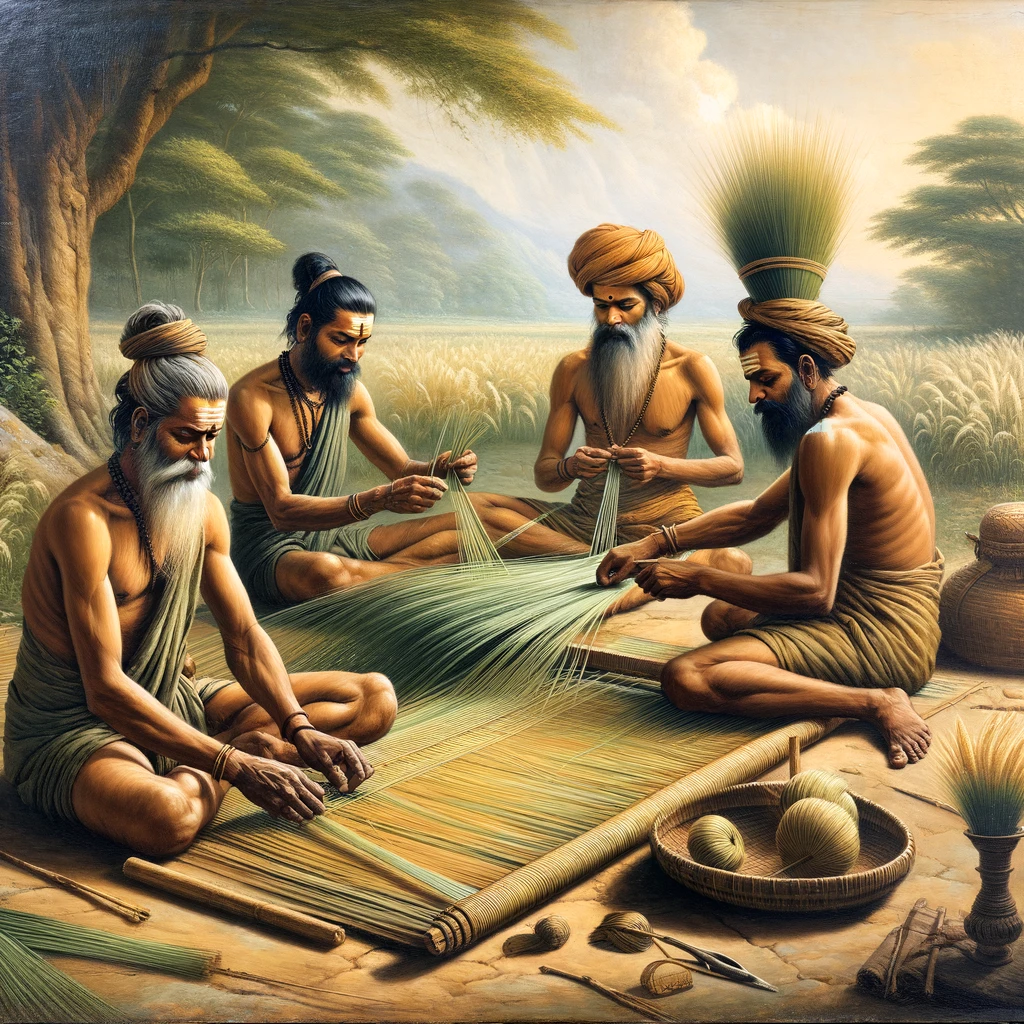
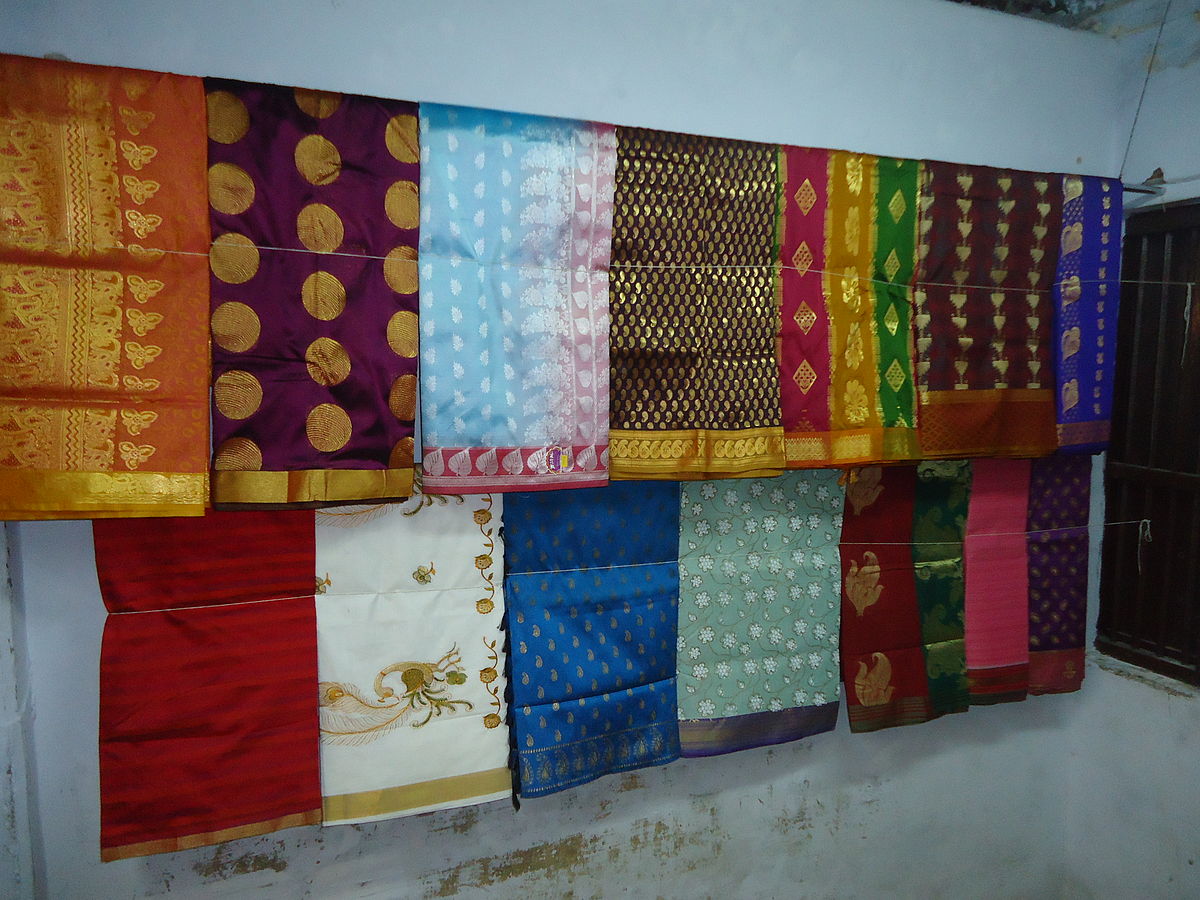
Thanks for your publiction. Another element is that just being a photographer entails not only difficulty in taking award-winning photographs but also hardships in acquiring the best photographic camera suited to your needs and most especially struggles in maintaining the quality of your camera. This is very real and clear for those professional photographers that are straight into capturing a nature’s exciting scenes — the mountains, the particular forests, the particular wild or the seas. Going to these exciting places unquestionably requires a camera that can surpass the wild’s harsh surroundings.
I really appreciate this post. I抳e been looking all over for this! Thank goodness I found it on Bing. You have made my day! Thx again
How can I find out more about it?
Thanks for posting. I really enjoyed reading it, especially because it addressed my problem. It helped me a lot and I hope it will help others too.
You helped me a lot by posting this article and I love what I’m learning.
May I request that you elaborate on that? Your posts have been extremely helpful to me. Thank you!
Thank you for your articles. I find them very helpful. Could you help me with something?
Thank you for sharing this article with me. It helped me a lot and I love it.
Thank you for your articles. I find them very helpful. Could you help me with something?
You helped me a lot with this post. I love the subject and I hope you continue to write excellent articles like this.
Thank you for your post. I really enjoyed reading it, especially because it addressed my issue. It helped me a lot and I hope it will also help others.
Please tell me more about your excellent articles
Thank you for writing this post. I like the subject too.
Good web site! I truly love how it is easy on my eyes and the data are well written. I am wondering how I could be notified whenever a new post has been made. I’ve subscribed to your RSS which must do the trick! Have a nice day!
Thank you for providing me with these article examples. May I ask you a question?
Good web site! I truly love how it is easy on my eyes and the data are well written. I am wondering how I could be notified whenever a new post has been made. I’ve subscribed to your RSS which must do the trick! Have a nice day!
The articles you write help me a lot and I like the topic
Thank you for being of assistance to me. I really loved this article.
You’ve been great to me. Thank you!
Great content! Super high-quality! Keep it up!
Great beat ! I would like to apprentice while you amend your web site, how could i subscribe for a blog site? The account helped me a acceptable deal. I had been a little bit acquainted of this your broadcast provided bright clear concept
Throughout this grand design of things you’ll get an A+ for effort and hard work. Where you misplaced me ended up being on all the facts. As people say, the devil is in the details… And it could not be much more correct in this article. Having said that, let me inform you precisely what did give good results. Your writing is certainly incredibly engaging and that is most likely the reason why I am taking an effort in order to comment. I do not really make it a regular habit of doing that. 2nd, while I can certainly see a jumps in reasoning you come up with, I am not confident of how you appear to connect your ideas which in turn make your conclusion. For the moment I shall subscribe to your position but wish in the near future you connect the facts much better.
Thank you a lot for giving everyone an extremely brilliant chance to read critical reviews from this website. It’s always so lovely and packed with a lot of fun for me personally and my office mates to search your website no less than three times in a week to read the new things you have. And indeed, I’m just at all times amazed considering the awesome things served by you. Certain two ideas in this posting are basically the simplest we have all ever had.
Some really nice and useful information on this site, too I think the style and design holds good features.
I抦 not that much of a internet reader to be honest but your sites really nice, keep it up! I’ll go ahead and bookmark your website to come back later on. Cheers
I have observed that in digital cameras, special sensors help to target automatically. These sensors of some surveillance cameras change in contrast, while others make use of a beam with infra-red (IR) light, specially in low lighting. Higher spec cameras sometimes use a combination of both models and likely have Face Priority AF where the digicam can ‘See’ the face and focus only upon that. Many thanks for sharing your ideas on this blog.
Attractive component to content. I simply stumbled upon your weblog and in accession capital to say that I acquire in fact loved account your weblog posts. Any way I抣l be subscribing on your augment and even I achievement you get admission to constantly rapidly.
Thanks for your writing. I would love to say that a health insurance specialist also works well with the benefit of the coordinators of any group insurance coverage. The health broker is given an index of benefits searched for by an individual or a group coordinator. Such a broker does is hunt for individuals or maybe coordinators that best match up those wants. Then he shows his suggestions and if each party agree, this broker formulates a contract between the two parties.
I do not even know the way I ended up here, however I believed this submit was great. I do not recognize who you’re however certainly you’re going to a famous blogger in case you aren’t already Cheers!
Cheers!
Hi there just wanted to give you a quick heads up. The text in your post seem to be running off the screen in Opera. I’m not sure if this is a formatting issue or something to do with browser compatibility but I figured I’d post to let you know. The style and design look great though! Hope you get the issue resolved soon. Kudos
Thanks for the marvelous posting! I genuinely enjoyed reading it, you can be a great author.I will remember to bookmark your blog and will come back very soon. I want to encourage that you continue your great posts, have a nice evening!
I’ve been absent for some time, but now I remember why I used to love this blog. Thank you, I抣l try and check back more often. How frequently you update your website?
You’ve been great to me. Thank you! http://www.hairstylesvip.com
You helped me a lot with this post. http://www.hairstylesvip.com I love the subject and I hope you continue to write excellent articles like this.
[…] Introduction to Indian Textile Art History […]